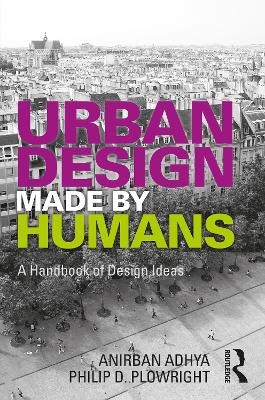
Urban Design Made by Humans
Routledge (Verlag)
978-1-032-18517-0 (ISBN)
The design of urban environments is complex and involves diverse needs, organisations, professions, authorities, and communities. It requires relationships to be constructed and sustained between infrastructure, resources, and populations across multiple scales. This can be quite daunting. However, at the core of urban design is a simple idea—our urban spaces are designed to allow people and communities to thrive. For that reason, a good starting point for urban designers is to focus on the way people think when engaging our built environment. This thinking is embodied, developed through the interactions between our mind, body, and the environment around us. These embodied concepts are central to how we see the world, how we move and gather, and how we interact with others. They are also the same ideas we use to design our environments and cities.
Urban Design Made by Humans is a reference book that presents 56 concepts, notions, ideas, and agreements fundamental to the design and interpretation of our human settlements. The ideas here parallel those found in Making Architecture Through Being Human but extends them into urban environments. Urban Design Made by Humans distinctly highlights priorities in urban design in how we produce meaningful environments catering to wider groups of people. Each idea is isolated for clarity with short and concise definitions, examples, and illustrations. They are organised in five sections of increasing complexity. Taken as a whole, the entries frame the priorities and values of urban design while also being instances of a larger system of human thinking.
Anirban Adhya is Associate Professor of Architecture and Urban Design at Lawrence Technological University, USA. He focuses on highlighting underlying dimensions of architecture in the city that connects urban ecology, spatial typology, and everyday urbanism. His previous book, Shrinking Cities and First Suburbs: The Case of Detroit and Warren, Michigan (Palgrave, 2017) illustrated the ecology of problems and responses in metro Detroit. He has also written on evolving notions of publicness in The Public Realm as a Place of Everyday Urbanism (University of Michigan Press, 2008), and worked with communities in Buffalo, New York; Warren, Michigan; Seattle, Washington; and Monteverde, Costa Rica. Philip D. Plowright is Professor of Architecture and Design Theory at Lawrence Technological University, USA. His interest focuses on developing clarity around foundational knowledge in the applied design disciplines for use in teaching and production environments. His previous book, Making Architecture by Being Human (Routledge, 2020), presented the cognitive building blocks of spatial semantics between individuals and spaces in relation to architectural values. He has also explored cognitive methodology in Revealing Architectural Design (Routledge, 2014), and embodied meaning in Qualitative Embodiment in English Architectural Discourse (Universidad de Castilla-La Mancha, 2017).
What This Book is About
Thinking is Designing
Urban Design is Not Big Architecture
How To Use This Book
Formal Concepts
Axis
Balance
Boundary
Centre
Compactness
Complexity
Containment
Density
Edge
Expansion
Figure-Ground
Grain
Grid
Motion
Node
Path
Pattern
Situated Notions
Block
Capacity
Co-Awareness
Connectedness
Co-Presence
Corridor
District
Frontage
Landmark
Legibility
Mobility
Permeability
Rhyme
Rhythm
Space
Visibility
Walkability
Socio-spatial Ideas
Accessibility
Activation
Coherence
Control
Locality
Presence
Publicness
Resilience
Sensibility
Separation
Stability
Typology
Use
Socially Constructed Agreements
Authenticity
Character
Choice
Diversity
Identity
Interest
Place
Symbol
Typo-morphology
| Erscheinungsdatum | 20.09.2022 |
|---|---|
| Zusatzinfo | 99 Halftones, black and white; 99 Illustrations, black and white |
| Verlagsort | London |
| Sprache | englisch |
| Maße | 129 x 198 mm |
| Gewicht | 453 g |
| Themenwelt | Naturwissenschaften ► Biologie ► Ökologie / Naturschutz |
| Technik ► Architektur | |
| ISBN-10 | 1-032-18517-1 / 1032185171 |
| ISBN-13 | 978-1-032-18517-0 / 9781032185170 |
| Zustand | Neuware |
| Haben Sie eine Frage zum Produkt? |
aus dem Bereich


